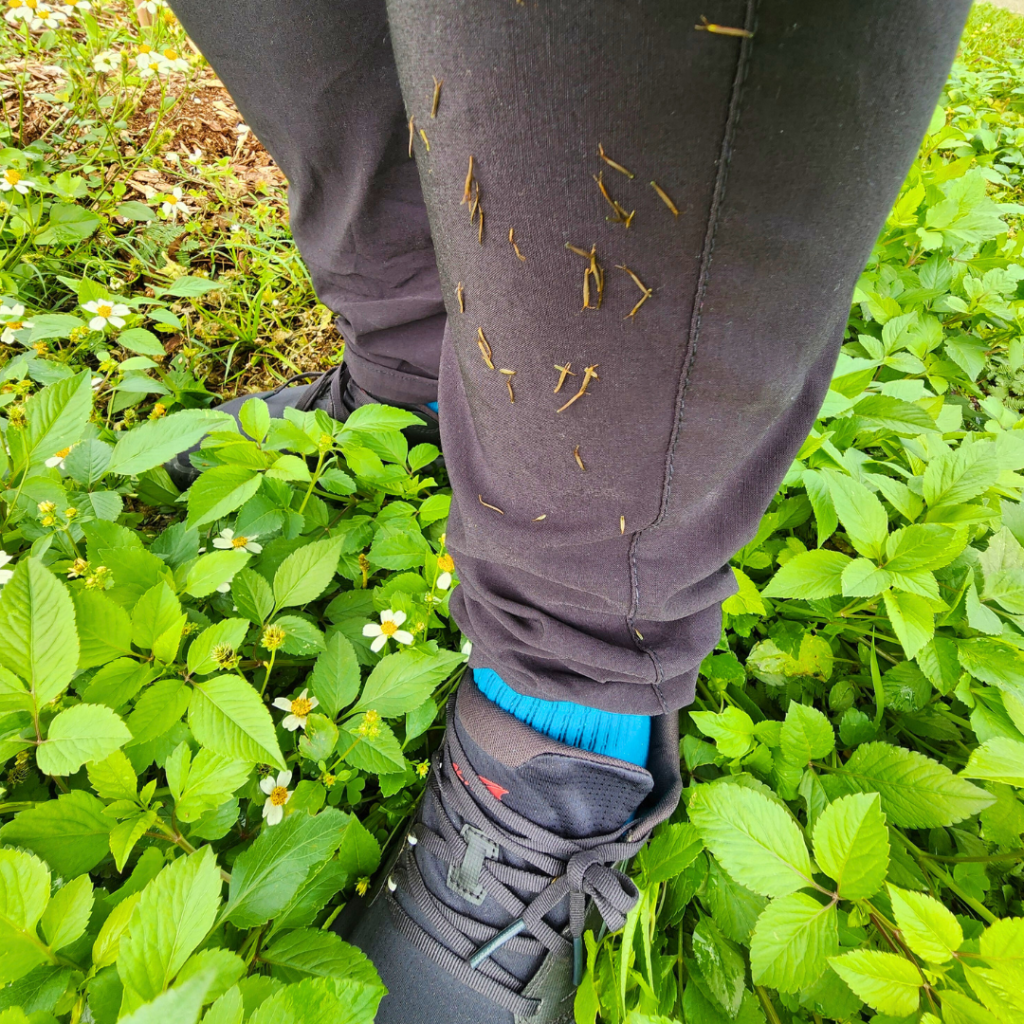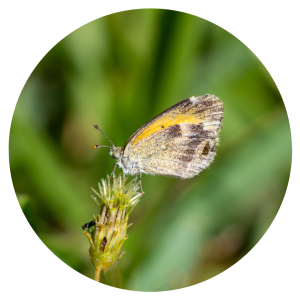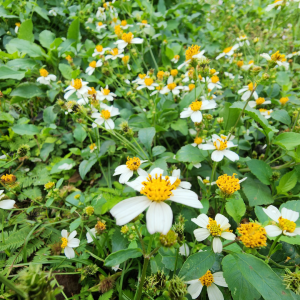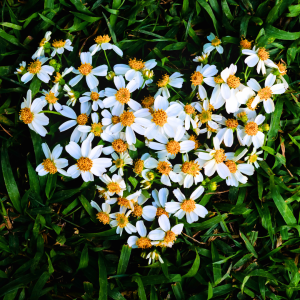A handful of the “lawn ornaments” that will be featured in this blog series. Top row (left to right): sunshine mimosa, perennial peanut, frogfruit, and fleabane. Bottom row (left to right): pennywort, Lobelia, Florida snow, and blue-eyed grass.
Welcome to our Lawn Ornament blog series, where we explore the plethora of micro-plants that can help create a biodiverse, predominantly green, yet also delightfully colorful lawn that requires much less maintenance than a traditional grass lawn.
Many homeowners find it difficult and costly to maintain a “traditional” lawn, one largely dominated by a single grass cultivar. Embracing a biodiverse landscape can ease the frustration and save money, with the added bonus of providing ecological benefits. This “Lawn Ornament” series will provide a road map to that goal. Along the way, we’ll showcase volunteer “weeds” and commercially available ground covers that can improve upon the biodiversity of our lawns. We will also offer you tips and techniques to adopt and embrace this biodiverse approach. Breaking free from tradition, we can transform yards and neighborhoods to vibrant, beautiful mixed-mowable ecosystems.
Make sure to check out the Starter Guide: Embracing Lawn Ornaments: A Starter Guide
Butterfly Needles! Florida’s Best Wildflower?
In the tapestry of Florida’s possible lawn ornaments, one plant really stands out for its resilience and ecological importance – Butterfly Needles, scientifically known as Bidens alba. Sarasota County’s FFL community educator, Forest Hecker, considers this plant ‘Florida’s Best Wildflower‘ due to these qualities and more! Today, we delve into the world of Bidens alba, exploring its common names, ideal growing conditions, ecological / agriculture / ethnobotanical significance, and the debate surrounding its native status. Currently, in Florida’s late winter and early spring, Bidens alba provides some of the lushest foliage and most abundant blooms of any plant.

Common Names
The Bidens alba is a wildflower with a wealth of common names, almost all of them reference the seeds which, like little needles, stick anything that passes by. Fortunately, unlike the sandbur, they do not puncture skin or cause any irritation. Instead they cling to clothes, hair, and feathers of anything passing by. Some names I uncovered during this research are Spanish Needles, Beggar’s Ticks, or even Monkey Lice. All named after their nature as a hitchhiking seed. Butterfly Needles is the common name I am going with, as most of the names are quite negative to this important plant.
Habitat and Thriving Conditions
This wildflower has adapted to human-disturbed landscapes, showcasing its ability to flourish in environments where many other plants struggle. It thrives in areas with less frequent and higher mowing. This adaptability make it a common sight along roadsides, utility easements, and other human altered areas. Whether incorporated into lawns through seasonal or higher mowing or kept in small pocket patches, Butterfly Needles are a welcome addition, inviting wildlife and pollinators to thrive.
Florida’s Best Wildflower?

Bidens alba has earned the reputation of being one of Florida’s best wildflowers, not only for its blooming abundance but also for its ecological value. Acting as a host plant for the Dainty Sulphur butterfly, it supports a myriad of pollinators as forage, contributing to the intricate web of insect biodiversity in the region.
Is this plant a key player in the United State’s agriculture?
This plant is considered one of the top three most important plants for our state’s honeybees. Our honey bees, while not native and not the bees we should be focused on when it comes to ecology, are crucial for our country’s food supply and security, providing 80% of the pollination for our flowering agriculture plants. Bidens alba is peaking when hives from all over the country are overwintering in Florida. Nourishing these hard workers before they are shipped all over the country to pollinate our almonds, apples, and citrus. I think this connection between abundant winter forage and our agricultural systems is understudied and unappreciated by many.

Important flowers? Lets talk seeds!
The numerous seeds produced by Butterfly Needles provide a valuable food source for wildlife, including Painted Buntings. These beautiful small seed eating birds need these natural food sources while migrating through our area or overwintering in our area.
Edibility and Ethnobotany?
Beyond its ecological role, Butterfly Needles does have historical uses in ethnobotany. It’s fresh flowers and newer leaves were utilized by some in salads. While other cultures have dried the leaves to use in teas. While not a staple in modern diets, this is an interesting subject to research. I personally would advise against trying this plant even with expert guidance. It thriving along roadsides and other disturbed areas does not bode well for what chemicals and pollutants the plant might have accumulated.

Native or Nonnative?
While widely considered native, there is ongoing debate about if the plant is truly a Florida native. Several very well respected naturalists put it in the same group as Tropical Sage and Golden Dewdrop, as plants that are widely labeled native but do not seem to exist in untouched wilderness. This plant seems to only occur in disturbed (mowed) areas like the definitively nonnative ‘Florida Snow’. Despite this debate, its ecological contributions and adaptability to human-altered landscapes make it a valuable addition to the Florida landscape in my eyes. I definitely do not think it is worth any herbicidal use, because even if it is nonnative, it doesn’t displace native vegetation like an invasive plant.
Cultivation and Varieties
In cultivation, Butterfly Needles can be available in a pink version, adding a splash of color to gardens. This is a naturally occurring color morph that has been cultivated. I also have observed what I consider dwarf versions, potentially driven by evolutionary pressures from our mowing practices. Maybe as the years go on this plant will become better at growing in frequently mowed areas. If it does I think it will benefit ecology as a great Lawn Ornament.

Conclusion
Bidens alba, otherwise known as Butterfly Needles, has an important role in supporting wildlife, pollinators, and maybe even Florida’s agriculture economy. I believe this makes it a valuable asset as a Lawn Ornament as you build a living, beautiful tapestry of a lawn. Embrace the beauty of this wildflower, and let the wildlife and pollinators thank you for your ecological stewardship.
Resources
- UF/IFAS EDIS document on Bidens alba: https://ufdcimages.uflib.ufl.edu/IR/00/00/70/37/00001/FW00500.pdf
- FNPS on Bidens alba: https://www.fnps.org/plant/bidens-alba
- UF/IFAS Bidens alba Fact Sheet: https://sfyl.ifas.ufl.edu/media/sfylifasufledu/duval/horticulture/homowner-hort-pdfx27s/Bidens_alba.pdf
- USF Plant Atlas (Native or Nonnative resources: https://florida.plantatlas.usf.edu/plant.aspx?id=3604
During the preparation of this work, the author used ChatGPT to help build the blog post. After using this tool/service, the author reviewed and edited the content, and takes full responsibility for the content of the publication.
Source: UF/IFAS Pest Alert
Note: All images and contents are the property of UF/IFAS.




